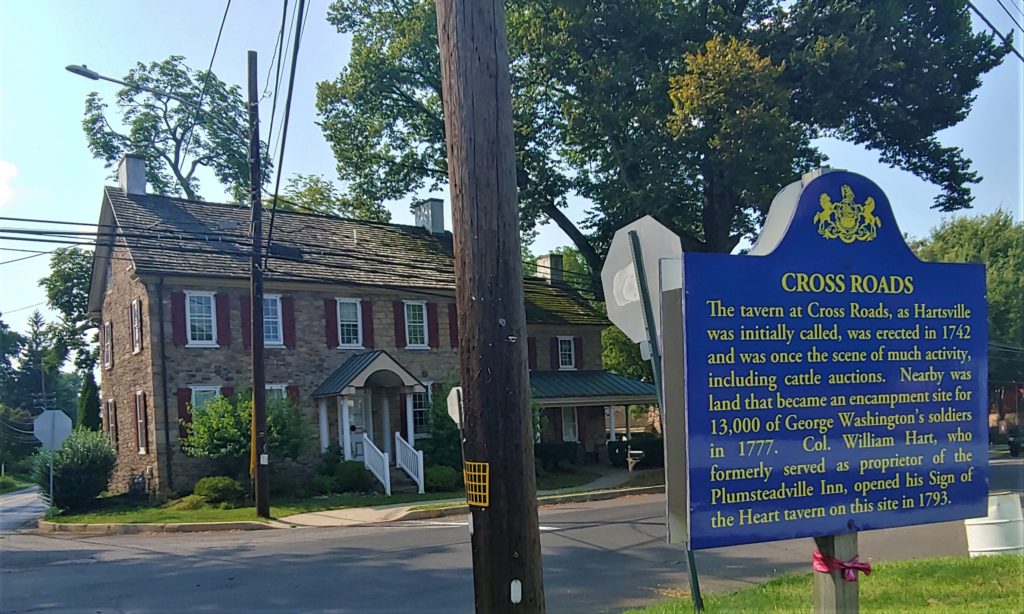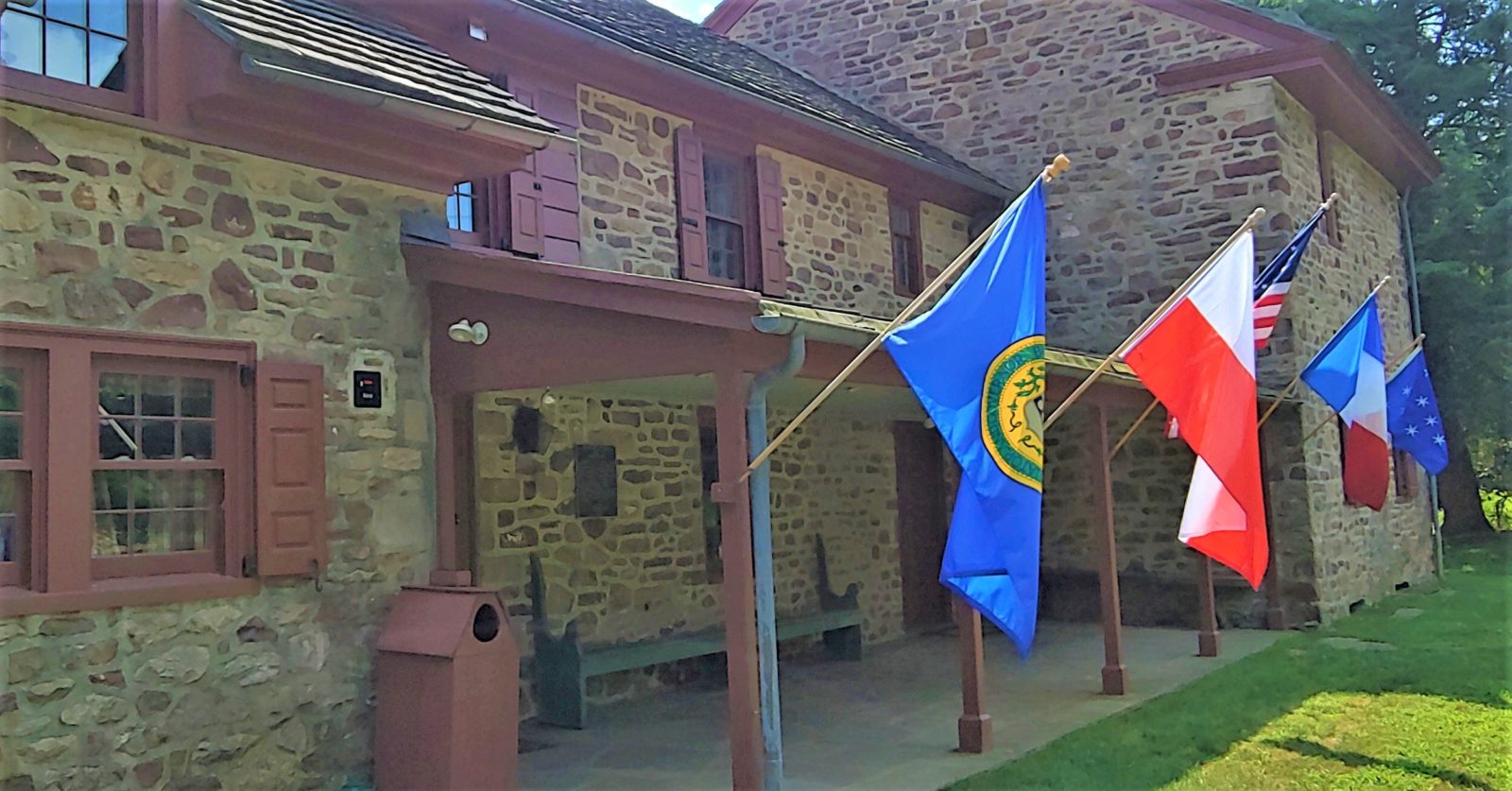Wartime crisis and a Plumsteadville veteran gave Hartsville a niche in history.
Hartsville isn’t a township nor borough. Though tiny, big things went down in the Warwick settlement.
For 13 days in 1777 George Washington resided in the widow Moland’s house on Old York Road, his longest stay at a single place in Bucks County during the American Revolution. His Continental Army of 11,000 and a few thousand followers encamped around him. It’s there the first official American battle flag arrived from Congress. It’s also where the Marquis de Lafayette of France and Polish Count Casimir Pulaski – “father of the American cavalry” – joined the Revolution.
Among infantrymen was Colonel William Hart of Plumsteadville who would have an indelible effect on the area after the war. More on that later.

Two weeks ago, I met tour guides Dave Mullen, Sue Goldsworthy and Maddie Seipp at the Moland House. It was a sweltering day reminiscent of when Washington was there. The two-story, fieldstone home with air conditioning reminded me of a very nice three-bedroom colonial. “With no bath,” laughed Dave. What did the commander-in-chief do? We know he issued bars of soap, pointing soldiers down the hill to Little Neshaminy Creek. Did one draw a pail of water and douse Washington on the lawn, or did George frolic with his men in the Neshaminy? No one knows for sure.
At the time, the area was best known for Cross Roads a half-mile away. It’s where Bristol Road to the county’s only seaport intersected York Road, the main Colonial highway between New York and Philadelphia. On Aug. 10, 1777 the Continental Army was encamped on the Moland property when news arrived a British fleet with 17,000 troops had sailed from Manhattan. The army lingered for nearly two weeks, waiting to figure out what the Brits were up to. Would they attack Philadelphia from the Delaware River? Or sail south to take the rebel stronghold at Charleston, S.C.? New finally arrived on Aug. 21 from John Hancock in Philadelphia indicating the enemy had been spotted sailing south 50 miles off Cape May, N.J.
Washington immediately convened a war council inside the Moland House. He and his generals concluded the enemy was targeting Charleston. That opened the way for a counterattack on New York. Advance elements of Washington’s army began moving up York Road the next day to carry out the new mission. Before camp was struck however, a courier arrived with sobering news: The British fleet had been spotted at the headwaters of the Chesapeake, off-loading troops, horses and equipment to march on Philadelphia through northern Delaware. Abruptly, Washington cancelled the move on New York. At 3 a.m. on Aug. 23, he and the Continental Army headed for Brandywine Creek below Philly to head off the Redcoats. Though outnumbered by 6,000 soldiers, Washington believed the terrain favored him.

As it turned out, the British outmaneuvered the general on Sept. 11, inflicting 1,100 casualties and forcing Washington’s retreat to Valley Forge. The Battle of Brandywine led to a 9-month British occupation of Philadelphia before Washington regained strength and eventually won the war.
William Hart returned home, relocated to Cross Roads and in 1793 founded the Sign of the Heart inn that redefined the area as Hartsville. The colonel later was elected register of wills and county commissioner before his death in 1831.
The outbreak of the Civil War 30 years later brought out villagers to honor a new generation of patriots. The 1,000-man 104th Infantry Regiment based in Doylestown arrived on Oct. 17, 1861 for a farewell banquet at the Sign of the Heart before marching off to war down York Road. Whittingham Livezey, a regimental officer, returned 44 years later. “I could see again the men in their bright, clean uniforms, the long lines of guns stacked and glistening in the sunshine, the 11 tables 40 feet in length loaded with luxuries such as roast beef, veal, mutton, chicken, boiled ham by the hundred weight, bread, pies and cakes by the wagon load. I stood for some time in deep meditation, thinking how many hundreds there were upon that beautiful autumn day, young men in the bloom of life, who partook of their last substantial meal of that description. Their bones are moldering today in the soil of Virginia, the Carolinas and Florida.”

The Moland House eventually became a dilapidated boarding house and motorcycle gang hangout that Warwick condemned as unsafe in 1985. When all hope seemed lost, a community action group in concert with a developer rescued the property and restored the house. Today it’s magnificent and open to public tours. It’s safeguarded by the Warwick Township Historical Society which keeps alive the story of what happened there through period furnishings, historical records and guides like Dave, Sue and Maddie.
Not so lucky was the Sign of the Heart. It was bulldozed for a gas station.
Sources include “Place Names in Bucks County Pennsylvania” by George MacReynolds published in 1942, and the Moland House website at www.molandhouse.org

